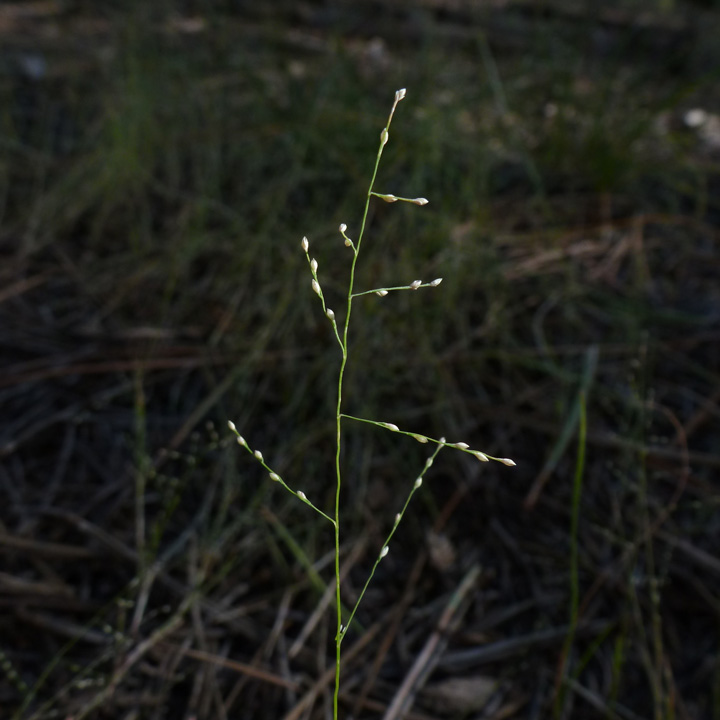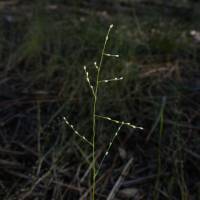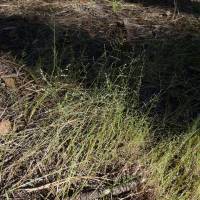Plants annual. Culms (3)5-25 cm, erect, branching, but not rooting, basally; internodes glabrous, mostly smooth, sometimes scabridulous below the nodes. Sheaths usually shorter than the internodes, glabrous, smooth or scabridulous; ligules 0.2-0.5 mm, hyaline, truncate, ciliate, without lateral lobes; blades 0.5-3 cm long, 0.8-1.2 mm wide, involute or flat, glabrous abaxially, puberulent adaxially. Panicles (1)2-9 cm long, 0.6-2.7 cm wide, open, ovoid or deltoid, spikelets sparse; primary branches (0.5)1-3.2 cm long, about 0.1 mm thick, ascending, spreading 20-100° from the rachises; pedicels 1-3 mm long, 0.5-1.5 mm thick, stiff. Spikelets 0.8-1.3 mm, appressed or divaricate. Glumes equal, 0.4-0.7 mm, glabrous, 1-veined, obtuse or subacute, unawned; lemmas 0.8-1.3 mm, oval, plump, mottled with greenish-black and greenish-white or ochroleucous patches, glabrous or shortly appressed-pubescent on the margins and midveins, apices acute, unawned; paleas 0.7-1.3 mm, oval; anthers 0.2-0.3 mm, purplish. Caryopses 0.5-1 mm, elliptic, brownish. 2n = 20.
Muhlenbergia ramulosa grows in open, well-drained areas including slopes, sandy meadows, washes, gravelly road cuts, and rock outcrops in yellow pine-oak forests and in open meadows of pine-fir forests, at elevations of 2100-3500 m. Its range includes the southwestern United States, Mexico, Guatemala, Costa Rica, and Argentina.
Common Name: green muhly
Duration: Annual
Nativity: Native
Lifeform: Graminoid
General: Annual with simple stems 5-25 cm, erect, branching but not rooting basally, internodes glabrous, smooth, sometimes minutely roughened below the nodes, sheaths shorter than internodes, glabrous, smooth or minutely roughened.
Vegetative: Blades 0.5-3 cm long, 0.5-1 mm wide, involute or flat, glabrous below, puberulent above, ligules less than 0.5 mm, hyaline, truncate, ciliate.
Inflorescence: Open panicle 2-9 cm long, 0.5-3 cm wide, ovoid or deltoid, with sparse spikelets, primary branches 1-3.2 cm long, 0.5-1.5 mm thick, stiff, spikelets 0.8-1.3 mm, appressed or divaricate; glumes equal, 0.4-0.7 mm, glabrous, 1-veined, obtuse or subacute, unawned; lemmas 0.8-1.3 mm, oval, plump, mottled with greenish-black and greenish-white patches, glabrous or shortly appressed pubescent on the margins and midveins, unawned.
Ecology: Found on open slopes, in marsh meadows, wet soil of canyons, to sandy meadows and washes, and rock outcrops from 7,000-10,000 ft (2134-3048 m); flowers August-September.
Notes: Distinguished by the loosely contracted stem with reflexed branches, the blades without whitish midnerve or margins, the lemma unawned.
Ethnobotany: Unknown
Etymology: Muhlenbergia is named for Gotthilf Heinrich Ernst Muhlenberg (1753-1815) a clergyman and botanist from Pennsylvania; ramulosa means slightly branched.
Synonyms: Muhlenbergia wolfii, Sporobolus ramulosus
Editor: SBuckley, 2010






